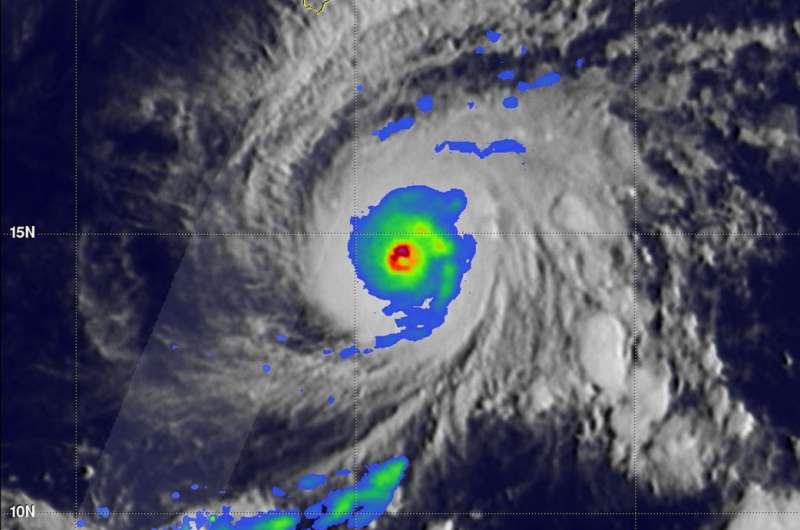GPM sees Hurricane Lane threatening Hawaiian islands with heavy rainfall

The GPM core observatory satellite flew over the Central Pacific Ocean and Hurricane Lane on Aug. 22, 2018 and analyzed rainfall rates and cloud heights. Watches and Warnings are in effect in the Hawaiian Islands.
The Global Precipitation Measurement mission or GPM core satellite passed over Lane at 1:48 a.m. EDT (0548 UTC/ on Aug. 21, 2018 at 7:48 p.m. HST). At that time Lane was located about 316 nautical miles (585.2 km) from Hilo, Hawaii.
Hurricane Lane is one of the strongest tropical cyclones to move into the Hawaiian Islands.
At the time of this GPM pass Lane was a category five on the Saffir-Simpson hurricane wind scale with winds of about 140 knots (161 mph). This analysis shows precipitation derived from data collected by the GPM satellite's Microwave Imager (GMI) and Dual-Frequency Precipitation Radar (DPR) instruments. GPM's GMI showed that very heavy rain was occurring with powerful storms located in Hurricane Lane's well defined eye wall. GMI revealed that moderate to heavy rainfall was also covering a large area extending outward from Lane's eye.
A 3-D image, created at NASA's Goddard Space Flight Center in Greenbelt, Md. showed the use of GPM satellite's radar data (DPR Ku Band) in conjunction with NOAA's GOES-West satellite infrared data to estimate the heights of storms within Hurricane Lane. Estimated storm top heights were over 6.2 miles (10 km). Cloud tops in a band of thunderstorms well southwest of the center were over 9.2 miles (14.9 km).
GPM is a joint mission between NASA and the Japan Aerospace Exploration Agency, JAXA.
Watches and Warnings
Warnings and watches are up in the Hawaiian Islands. NOAA's Central Pacific Hurricane Center said aHurricane Watch is in effect for Central Oahu, Kauai Leeward, Kauai Mountains, Kauai Windward, Niihau, Oahu Koolau, Oahu North Shore, Oahu South Shore, Olomana, Waianae Coast, and Waianae Mountains
A Hurricane Warning is in effect for Big Island Interior, Big Island North and East, Big Island Summits, Haleakala Summit, Kahoolawe, Kohala, Kona, Lanai Makai, Lanai Mauka, Leeward Haleakala, Maui Central Valley, Maui Leeward West, Maui Windward West, Molokai Leeward, Molokai Windward, South Big Island, and Windward Haleakala.
Location and Strength of Hurricane Lane on Aug. 22
NOAA's CPHC said at 11 a.m. EDT (5 a.m. HST/1500 UTC), the center of Hurricane Lane was located near latitude 15.1 degrees north and longitude 155.3 degrees west. That's about 315 miles (505 km) south of Kailua-Kona, Hawaii and about 460 miles (740 km) south-southeast of Honolulu, Hawaii.
Lane is moving toward the west-northwest near 9 mph (15 kph) and this motion is expected to become northwest later today, followed by a turn to the north-northwest on Thursday. On the forecast track, the center of Lane will move very close to or over the main Hawaiian Islands from Thursday through Saturday, Aug. 25.
Maximum sustained winds are near 155 mph (250 kph) with higher gusts. Lane is a category 4 hurricane on the Saffir-Simpson Hurricane Wind Scale. Some weakening is forecast during the next 48 hours, but Lane is forecast to remain a dangerous hurricane as it draws closer to the Hawaiian Islands.
Hurricane-force winds extend outward up to 40 miles (65 km) from the center and tropical-storm-force winds extend outward up to 140 miles (220 km). The estimated minimum central pressure is 935 millibars.
Situation Overview from CPHC on Aug. 22
CPHC stated "Major Hurricane Lane is passing roughly 280 miles south of the Big Island this morning and has started a turn towards the northwest in line with the Central Pacific Hurricane Center forecast. The center of Lane will track dangerously close to the Hawaiian Islands from Thursday, Aug. 22 through Saturday, Aug. 25.
Regardless of the exact track of the storm center, life threatening impacts are likely over some areas as this strong hurricane makes its closest approach. Just a reminder that impacts from a hurricane extend far from the center of the storm and slight changes to the forecast track this close to the islands will produce rapid changes to the local forecast impacts."
The CPHC forecasts that "the current forecast track will bring local impacts of damaging winds and life threatening flooding rain across the state from Wednesday through Saturday".
Provided by NASA's Goddard Space Flight Center





















